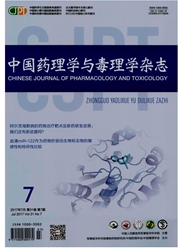

 中文摘要:
中文摘要:
目的研究脂类干扰剂非律平和制霉菌素对人羊膜上皮细胞鞘脂类代谢的影响是否相同。方法应用基质辅助激光解吸附飞行时间质谱分析方法分析不同剂量非律平和制霉菌素对人FL细胞株鞘脂类代谢的影响。结果非律平和制霉菌素均可影响FL细胞鞘脂类代谢,但是非律平(0.2和10μmol·L^-1)诱导了多种新的神经酰胺类分子的合成,推测主要影响神经酰胺类分子的代谢。而制霉菌素(0.054和0.108μmol·L^-1)在诱导了新的神经酰胺分子合成的同时,还导致鞘磷脂含量的增高,0.108μmol·L^-1可诱导更多神经酰胺分子的合成,推测制霉菌素可能对鞘磷脂类分子和神经酰胺类分子的代谢都有影响。结论非律平和制霉菌素均干扰鞘脂类代谢,但二者的靶点可能不同。
 英文摘要:
英文摘要:
AIM To study whether macrolides polyene antibiotics filipin and nystatin have different effects on sphingolipids metabolism in human amnion epithelial (FL) cells. METHODS After FL cells were treated with two concentrations of filipin (0.2 and 10 μmol·L^-1) and nystatin (0. 054 and 0. 108 μmol·L^-1), respectively, sphingolipids were extracted and subjected to matrix-assisted, laser desorption-ionizing-time of flight mass spectrometry analysis. RESULTS Both filipin and nystatin affected sphingolipids .metabolism. However, filipin (0.2 and 10μmol·L^-1) mainly affected ceramide, and induced the generation of many new ceramide species. On the other hand, nystatin (0.054 and 0. 108 μmol·L^-1) affected both ceramide and sphingomyelin. In addition to the induction of new ceramide species, nystatin also increased the concentration of several sphingomyelin species. Nonetheless, the higher concentration of nystain (0.108μmol·L^-1) induced the generation of more ceramide species than the lower concentration of nystatin (0.054μmol·L^-1). CONCLUSION Both filipin and nystatin affect sphingolipids metabolism, however they may target different steps in the sphingolipids metabolism pathway.
 同期刊论文项目
同期刊论文项目
 同项目期刊论文
同项目期刊论文
 A Lipidomic Study of the Effects of N-methyl-N'-nitro-N-nitrosoguanidine on Sphingomyelin Metabolism
A Lipidomic Study of the Effects of N-methyl-N'-nitro-N-nitrosoguanidine on Sphingomyelin Metabolism Nystatin interferes with the effects of N-methyl-N '-nitro-N-nitrosoguanidine on sphingolipid metabo
Nystatin interferes with the effects of N-methyl-N '-nitro-N-nitrosoguanidine on sphingolipid metabo 期刊信息
期刊信息
